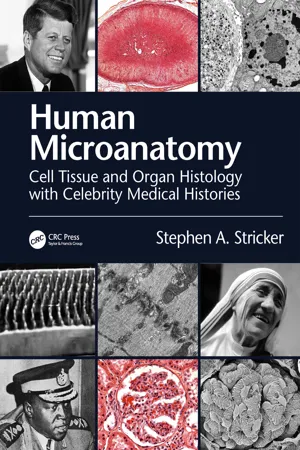
Human Microanatomy
Cell Tissue and Organ Histology with Celebrity Medical Histories
- 420 pages
- English
- ePUB (mobile friendly)
- Available on iOS & Android
Human Microanatomy
Cell Tissue and Organ Histology with Celebrity Medical Histories
About this book
Human Microanatomy is a comprehensive histology text that analyzes human structure and function from the subcellular to organ level of organization. In addition to emphasizing medically relevant information, each chapter considers developmental and evolutionary aspects of microanatomy while also using celebrity medical histories to help provide real-world context for accompanying descriptions of normal histology. The book is richly illustrated with over 1400 full-color micrographs and drawings assembled into cohesive groupings with detailed captions to help elucidate key histological concepts. Text illustrations are further supplemented by hundreds of other light and electron micrographs available in a free digital atlas covering a broad spectrum of microanatomy. Each text chapter also includes a preview, pictorial summary, and self-study quiz to highlight and review essential elements of histology. By incorporating features like medical histories, biological correlates, and various study aids, Human Microanatomy provides an appealing and informative treatment of histology for readers who are interested in the structural bases of cell, tissue, and organ functioning.
KEY FEATURES:
- Uses celebrity medical histories to help provide context for descriptions of normal histology
- Supplements medically relevant information with developmental and evolutionary correlates of microanatomy
- Contains 1400+ full-color micrographs and drawings that illustrate a wide range of histological features
- Offers free access to an ancillary online atlas with hundreds of additional light and electron micrographs
- Includes helpful study aids such as chapter previews, pictorial summaries, and self-study quizzes
- Presents a novel and comprehensive account of the structure and function of human cells, tissues, and organs
Frequently asked questions
- Essential is ideal for learners and professionals who enjoy exploring a wide range of subjects. Access the Essential Library with 800,000+ trusted titles and best-sellers across business, personal growth, and the humanities. Includes unlimited reading time and Standard Read Aloud voice.
- Complete: Perfect for advanced learners and researchers needing full, unrestricted access. Unlock 1.4M+ books across hundreds of subjects, including academic and specialized titles. The Complete Plan also includes advanced features like Premium Read Aloud and Research Assistant.
Please note we cannot support devices running on iOS 13 and Android 7 or earlier. Learn more about using the app.
Information
PART ONE CELL AND TISSUE HISTOLOGY—OVERVIEW OF HISTOLOGY, CELL STRUCTURE, AND TISSUES
- 1Introduction to Human Microanatomy and its Associated Techniques
- 2Primer of Cellular Ultrastructure
- 3Overview of Embryology and the Four Basic Tissue Typeswith Emphasis on Epithelium and Connective Tissue Proper
- 4Cartilage and Bone
- 5Adipose Tissue
CHAPTER 1 Introduction to Human Microanatomy and its Associated Techniques
PREVIEW
- 1.1 Human microanatomy and the general organization of this textbook
- 1.2 Cells, size scales, and limits of resolution in light microscopy (LM) vs. electron microscopy (EM)
- 1.3 Imaging live whole mounts by LM and preparing fixed sections for LM and TEM
- 1.4 Staining sections, histological artifacts, and interpreting microanatomical images
- 1.5 Identifying specific components in histological samples: polarization microscopy, autoradiography, and indirect immunofluorescence
- 1.6 Methods for reconstructing three-dimensional morphology from the subcellular to organ level of organization
- 1.7 Medical applications of microanatomical analyses
- 1.8 Summary and self-study questions
1.1HUMAN MICROANATOMY AND THE GENERAL ORGANIZATION OF THIS TEXTBOOK

1.2CELLS, SIZE SCALES, AND LIMITS OF RESOLUTION IN LIGHT MICROSCOPY (LM) VS. ELECTRON MICROSCOPY (EM)
Cell type | Estimated % of ∼30 trillion cells in adult human |
|---|---|
Erythrocytes | 84 |
Platelets | 4.9 |
Bone marrow cells | 2.5 |
Vascular endothelial cells | 2.1 |
Lymphocytes | 1.5 |
Hepatocytes | 0.8 |
Neurons and glia | 0.6 |
Epidermal cells | 0.5 |
All other cells | ∼3 |
Source: Data from Sender, R et al. (2016) Revised estimates for the number of human and bacteria cells in the body. PLoS ONE Biology 14: doi:http://dx.doi.org/10.1371/journal.pbio.1002533, reproduced under a creative commons license. | |
Table of contents
- Cover Page
- Half Title Page
- Title Page
- Copyright Page
- Dedication Page
- Contents
- Preface
- Acknowledgments
- Online Digital Atlas and Instructor Resources
- Part I Cell and Tissue Histology–Overview of Histology, Cell Structure, and Tissues
- Part II Tissue and Organ Histology– Blood, Circulatory and Lymphatic Systems, Muscles, Nervous System, and Skin
- Part III Organ Histology—Digestive, Respiratory, and Endocrine Systems
- Part IV Organ Histology– Urinary System, Reproductive Systems, and Sensory Organs
- Figure Citations for Medical Histories
- Index